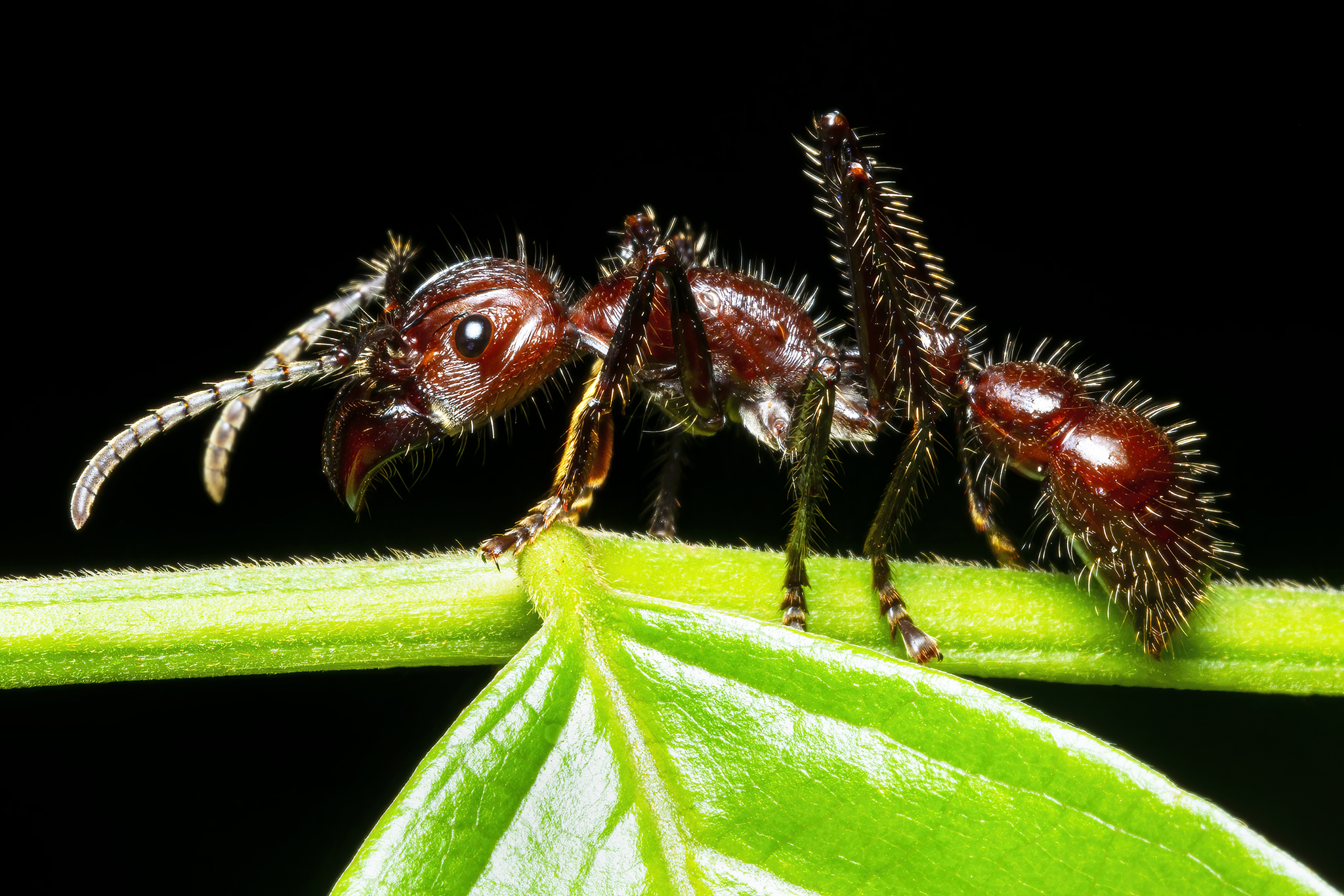Everyone say hello to the Bullet Ant, but don’t get too close…
Why is it called a Bullet Ant? Any theories?
Possibly because its shiny brown body looks a little bit like a bullet? Or maybe they’re really, really fast – blink and you’ll miss them?
Those are solid guesses, well done you, but unfortunately, they’re wrong.
This ant is called the Bullet Ant because if you happen to get stung by one of them, it feels like you’ve been shot. The Bullet Ant arguably has the most painful sting in the animal kingdom.
The person making this argument is American entomologist Justin O. Schmidt, author of the Schmidt Sting Pain Index. Over the last 40 years, Schmidt has been stung more than a thousand times by insects from over 150 different species. But nothing comes close to the Bullet Ant, he says.
While a lot of people would call Schmidt crazy, plenty of those people are probably working jobs they hate from nine to five every day – and I think that’s even more crazy. At least old mate Schmitty is living authentically and following his passions, even if they’re a little bit obscure.
The Bullet Ant is found at level 4 on the Schmidt Sting Pain Index, the highest ranking available. Schmidt describes the sting of a Bullet Ant as “pure, intense, brilliant pain – like fire-walking over flaming charcoal with a three-inch rusty nail grinding into your heel.”
Evocative. I love it. Thanks Schmitty.
While a handful of insect stings have a similar intensity of pain (the Tarantula Hawk Wasp and Warrior Wasp for example), it’s the duration of the experience that makes the Bullet Ant stand out. The pain can often continue unabated for up to 24 hours.
I’ve heard anecdotally from a couple of people that the sting isn’t as bad as these accounts suggest, and that descriptions like Schmidt’s are perhaps a bit exaggerated. However, it seems that the experience of a Bullet Ant sting can vary depending on personal biology as well as the individual ant you are stung by. It’s also worth noting that there are a couple of ant species that mimic Bullet Ants in order to appear scarier than they actually are – so it’s also possible that some people are being stung by ants that are just pretending to be Bullet Ants.
Needless to say, I wasn’t taking any chances, and was particularly careful getting up close for this photo.

While having the most painful sting on the planet has obvious defensive properties for the ants themselves, it also has fascinating cultural significance to the indigenous Sateré-Mawé people of the Brazilian Amazon.
The Sateré-Mawé utilise Bullet Ants as part of their initiation ritual for young boys wanting to become warriors. First, the ants are knocked unconscious by a natural sedative, and then hundreds of them are woven into gloves made out of palm leaves. The gloves resemble large oven mitts, with the stingers of the Bullet Ants facing inwards. At just 13 years of age, the initiate will place then his hands inside the gloves, with the aim being to keep them on for a full five minutes.
When Bullet Ants sting their victims, they also release a pheromone instructing other ants nearby to begin stinging as well. Consequently, the Bullet Ants in the glove are quickly whipped up into a stinging frenzy. At the conclusion of the ritual, the boy’s hands and lower arms are completely paralysed, and on top of the blinding pain, he will hallucinate and shake uncontrollably for several days.
As if this story wasn’t crazy enough, in order to fully complete his initiation, the boy will need to repeat this process a total of TWENTY TIMES over a period of several months if he wants to become a warrior. Amazingly, the whole experience leaves no permanent physical damage (psychologically, however, I’m not so sure).
Back in 2014, Australian comedians Hamish and Andy headed into the Amazon to experience one of these rituals first-hand (literally). I can only assume they didn’t know what they were getting themselves in for, because Hame drew the short straw and decided to voluntarily place his hands inside the stinging death mittens. Eight hours later, after being taken to a hospital and placed on a morphine drip, his pain finally subsided. They filmed the whole thing, and it makes for unbelievable viewing,

Now, let’s meet Ectatomma tuberculatum!
The best thing about Ectatomma tuberculatum is that it doesn’t appear to have a common name, which is fantastic because it means I just get to make one up. I’m gonna call them Little Brown Chompers on account of their disproportionately large mandibles.
Little Brown Chompers are a widespread ant in the neotropical regions of Central and South America, and the ones in this photo are in the process of transporting their larvae to a new location. This is quite a common behaviour in many ant species and will occur whenever a nest has been compromised. Ants abandon their nests for a whole variety of reasons, from disruption by predators like anteaters, to damage or destruction (by a careless human foot, for example), to invasion and conflict with other ants!
Interestingly, you’ll also notice that for Little Brown Chompers, the larval stage takes place in a cocoon. Some species of ants have larvae that spin their own cocoon out of silk, while others will develop ‘naked’, like little exhibitionists. Even more surprisingly, some species have been reported alternating between cocooned and naked larvae depending on the surrounding conditions.
But hang on, I hear you say, this was a post about Bullet Ants – why have the Little Brown Chompers hijacked this story?
Great question, read on to find out…

The Bullet Ant is one of the largest ants in the world. Growing over 3cm in length, it is second only to the Giant Amazonian Ant, which can reach up to 4cm. Consequently, Bullet Ants are often more like Bully Ants when it comes to the smaller species that live around them. It’s not clear what motivated our Little Brown Chomper friends to leave their nest, but I have a sneaking suspicion that these Bullet Ants had something to do with it.
I spent around half an hour watching the scene unfold on an unassuming tree trunk in the Peruvian Amazon. As the Little Brown Chompers frantically tried to evacuate, four gigantic Bullet Ants lay in wait, blocking their path. The Bullet Ants patrolled up and down the trunk of the tree, and would literally tear to pieces any other ants that they could get their jaws on. The entire spectacle was nature at its brutal best.
Bullet Ants are one of the most formidable insects on the planet, inspiring fear and respect in anyone and anything crazy enough to stumble across them. It was an absolute joy to finally see them in the wild!
–
Bullet Ants (Paraponera clavata), Los Amigos Biological Station, Madre de Dios, Peru


